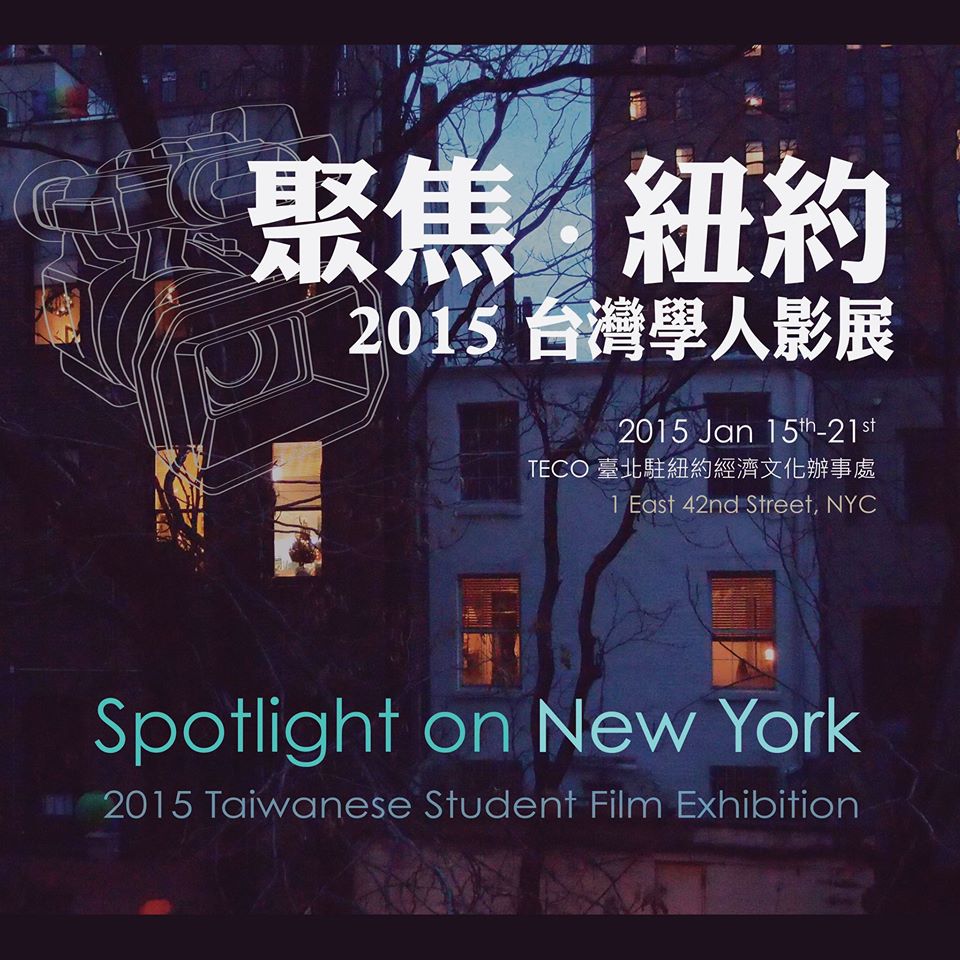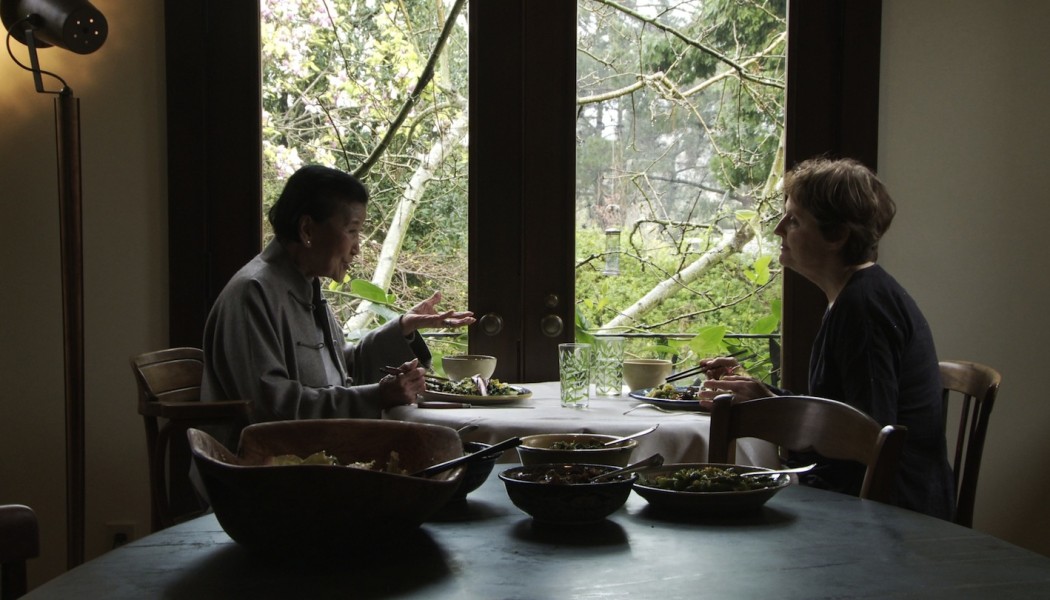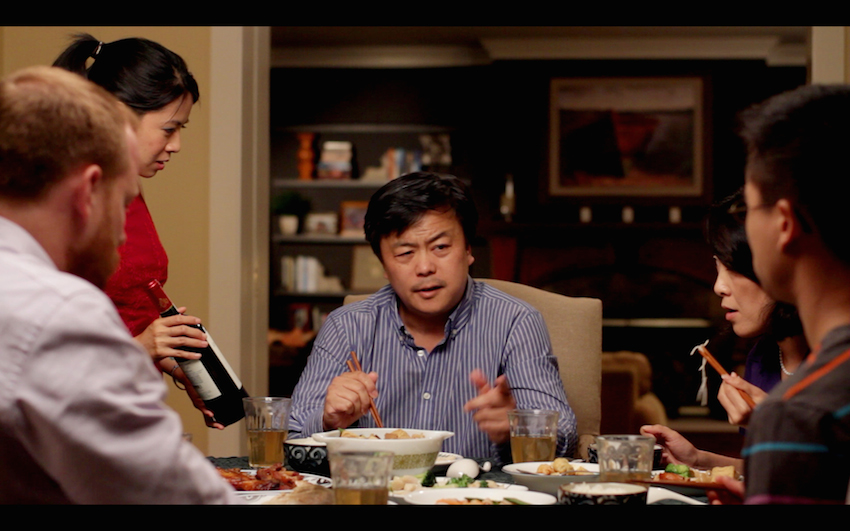Article by Jazmin Justo
The Taipei Economic and Cultural Office in New York hosted the 2015 Taiwanese Student Film Exhibition to demonstrate the great talent of the young filmmakers and also gives them the chance to show their short films to a larger audience. As a fellow movie viewer who enjoys watching a wide range of movies no matter how odd or how old, I felt honored to be able to watch the unique work from the Taiwanese filmmakers whose skills and creativity are on par professionally in both quality and creativity of their works. From animation to silent film, the students were able to show that they are more than capable of being able to handle all the work that it takes to make a high quality, thought provoking, enjoyable film in a variety of genre and story telling. I wish them all the best in their future works and look forward to seeing their work in the big screen soon.
The Rope is a black and white, silent film directed by Ting-Wu Cho, that focuses on a girl who is stuck in a world where everyone is tied to a piece of rope. The film begins with a girl in a large white room where there are ropes tied everywhere. There is a long rope that is tied around the girl that leads to another woman outside, who goes out for a walk. Mysteriously, the rope tied around the girl disappears but she follows the woman anyway. As she walks around, everyone is tied to a rope and the ropes are tied to other ropes. No one seems to display a lot of emotion as they go about their daily lives, while the girls’ existence tends to be ignored by everyone that walks past her. She then walks inside a park and meets an old man sitting at a bench. She notices that the old man too, has a piece of rope. Feeling out of place, she returns to the room to find a piece rope but they are all gone. She returns to the park to ask the man where he got his rope, but he also disappeared leaving nothing but a piece of rope. The rope in this film can be interpreted in various different ways. One possible interpretation can be how peoples’ lives are intertwined with one another without them even realizing it. The rope can also symbolize the person’s existence as with the case of the old man, who disappeared and left nothing but a piece of rope. Therefore, the girl who is lost but immersed in the world of ropes is like the viewer, lost but curious of what the mysterious world could be. The film incorporates eerie background music which emphasizes the inexplicableness of the world of ropes.
D-Day is a comical, slice of life drama directed by Yi Liu. D-Day revolves around eight college students who are friends, working last minute to finish their projects for their last theater auditions for their graduation year. Unfortunately for them, they are stuck with a director who is very peculiar and they are all stressed on making their projects perfect. However, the leader of the set design team suffers an artistic block, the lighting technician blows a fuse, and the two main actors of the group decide not to audition while the other actor is growing through a mental breakdown. Even though D-Day is a known military term for the infamous landing of the Allies on the shores of Normandy, in this case the drama class, like a military operation, have to fight against time as they work together to tackle the ultimate challenge: completing their projects. In the midst of last minute failures, the atmosphere becomes chaotic as the students stress about their life goals and ambitions while the actors think about quitting. The film is separated into five chapters, each focusing on a different group of friends displaying the family-like relationship everyone has for each other. Like a family, they have their good times but also have their moments of heightened emotion as the deadline draws near and nothing is completed. By chapter five, everyone gets together and tries to mediate the various conflicts occurring. The film is very easy to follow and the actors themselves use colloquial terms and are sometimes immature, which makes the film relatable in both experience and language to the younger audience. The timing of the film is also great as the first three chapters all end at the sound of a scream, building on the suspense. The scream is later revealed to be the heartbroken actor, screaming a soliloquy in an empty dance room. By chapter six, everyone has gone home after completing their work, and focuses on the set designer and heartbroken actor who have reconciled and realized that there is more to life than just deadlines and projects, but friendship and life ambitions that they should never lose sight of, despite the unexpected drama that happens in a drama class.
Starry Eyes is an upbeat colorful film directed by Chieh Yang, about a world called Lucky, where everyone lives happily with their one true love, which they call Lucky Star. In their planet, the people are able to find their Lucky Star by looking into their eyes. In an instant, they would fall in love instantly and live a happy life of good luck. Thanks to the invention of the “Eyebook” people can now find their Lucky Star faster than ever in their world of 6 billion people. The main protagonists Enoch, has used the Eyebook to find his own Lucky Star, a girl named Nunu. As he desperately searches for her, he ends up working for an eccentric doctor who knows NuNu, and is working on cloning eyes so that everyone can have a chance to find their Lucky Star. As the film progresses, Enoch is finally able to find NuNu through the memories he shares with her because they are each other’s Lucky Star. The film transitions between NuNu’s life and Enoch’s, as it explores the concept of what it means to be in love and what is happiness. NuNu becomes conflicted with this question, when she falls in love with her childhood friend but when Enoch finds her, she must choose between the two. With musical numbers, colorful eccentric settings, and emotional acting, the film is an emotional rollercoaster for anyone who enjoys romantic comedies with a bit of fun and tears. The film is also thought provoking as it also relates to the modern era where technology is used to find one’s “lucky star” in a world with billions of people, which makes the viewer ponder, what is happiness and what is love?
Envelopes directed by Yimei Huang is a short family drama about a Chinese father who anxiously waits for the return of his daughter who has come for a holiday family dinner party. As the father carefully waters his garden and meticulously arranges ornaments around his home, the viewer can get a sense of control the father possesses and his desire for everything to be perfect. When the daughter arrives, she brings home her Caucasian boyfriend whom she is currently living with. Surprised that his wife or son haven’t informed him, he gets upset that he has lost influence over his own children as they start making large decisions in life without his consent. As the film closes with a satisfying finale, the way the film is able to illustrate the meticulous relationship within the family through their commentaries and setting, as well through the symbolism of the garden and red envelopes, the film gives a perspective on the relationship between the parent and child, on what it means to be family and what it means to grow up.
Holding My Absence is a surreal film directed and produced by Huei Yin Chen. In the film, a girl who is in constant slumber explores the boundaries between reality and fantasy through images that transition from the past to present. The movie itself is a thought provoking piece that explores how reality is created through the images we see. It also questions if images can always be relied on as the truth. The film begins with a girl asleep on a train ride, dreaming about two women dressed in traditional Japanese clothing while riding a canoe at the midst of night. As the two woman ride the canoe, the scene changes quickly to a Japanese woman wearing a kimono, riding a yellow yacht heading straight towards viewer. The yacht then stops and the lifts itself vertically with the woman inside. As she continuously dreams the same image over and over, she begins to wonder if its really a dream or if it was a memory of hers that she has forgotten and has become a dream. The film then transitions to the girl searching for an apartment where she begins a photograph session with a mysterious lady in a dark room. As the girl begins taking photos of her in different angles and lighting, she remembers someone telling her that mythology only exists through images and that photography itself is like a ritual because of the preparations that are taken to create a photograph. As she takes photos, the film transitions to the same women who were in the canoe, taking a ride on a hand drawn spiral, part of a larger art piece of a traditional Japanese painting in a traditional Japanese home. As the film progresses, there are more transitions between the girls daily train ride to the apartment and clips from her dream, showing an old stone bridge where a woman runs under it, a Japanese lady looking into a red mirror while an elderly man in western clothes walks past her holding a candle, to an image depicting flowers drifting down the river on a straw boat. The film takes a twist and begins to unravel the story behind the images as she begins to hear a love story. Eventually, the images she sees in her dreams starts becoming a part of her reality without her realizing it. Through the amazing special effects and delicate work on detail, the short film is a strange but engaging in its presentation of the story while constantly posing the question of what is an image, how are images created and what role they play in our daily lives.
On Board directed by Mitch Lin, is a bittersweet, beautifully 2D animated story about the life of a grandfather who reminiscences about his youth. The film begins with the grandfather sitting on a rocking chair, watching his grandson play with a toy train. As he watches, he notices a photograph of himself with his wife. He sits back and through his grandson’s toy train, he finds himself on a train ride, watching his memories like a film, through the windows of the train. He watches himself age with his wife, from their happy youthful days as a young couple, to their marriage, to their parenthood years raising their first child, and then through their elderly years in which he would help his wife up to her final days. After reminiscing, the grandfather gets up from his chair and walks towards the entrance of the home and opens the door. Then there is a bright flash and he is gone. With the sound of elegant piano music playing at the background, it’s a bittersweet story we can all relate to as we all have parents or grandparents who at some point of our lives would also come to reminisce about their lives and like a train ride, would have to depart to another place, in which in the final credits, the grandfather is seen reunited with his wife on a train.
Owl and Mouse is a musical composition and a 5 minute animated short created by Meng-Mei Kuo, about the strange friendship between an owl and a mouse. On a rainy evening, Owl is playing the piano. Content and inspired, his piano playing is cut short by a knock at the door. In dismay, Owl answers the door and is surprised to a see a young white mouse at his porch. The young mouse asks if she could stay on the porch until the rain stops. The Owl is surprised to hear the request but lets her stay outside. However, the Owl’s conscience makes him think, “What if the mouse gets electrocuted by lightning?”. Giving in, the Owl allows the mouse to enter his home and makes her feel welcomed. The comical short is very sweet as the awkward Owl tries his best to resist temptation of eating the mouse while the mouse gains an interest on Owl’s piano. In the end, they are both happily playing the piano together until the rain stops and the mouse goes home. The careful details to the setting and characters brings out the warmth and forest life of the film as notes the use of felt, paper, leaves, clay, and wood were used in the 3D animation. Also the film uses live orchestra music composed by the director herself. The orchestra consisted of two flutes, two oboes, two clarinets, two bassoons, two horns, one trumpet, trombone, tuba, timpani, glockenspiel, xylophone, marimba, vibraphones, piano (four hands), harp, and strings. Altogether the classical music produced the mood and sound effects of the film, which gave the film originality and made the overall experience enjoyable.
Memoria de Octavia (Memories of Octavia), is a psychological short film directed by Marly Hernandez and production designed by Hui Chen. The film revolves around a girl named Octavia whose mother seeks asylum in the United States from Mexico because of a war that has caused the tragic loss of her husband. Octavia, having witnessed the tragedy has grown up with PTSD. The film then jumps forward to Octavia as a young woman who works as a scientist and her mother recently passed away. Due to her research, she’s stumbled upon the scientific work of neuroscientists Karim Nader and Joseph Ledoux, about the possibilities of being able to reconstruct memories. Using herself as a test subject, she tries to erase her own tragic memories by taking pills. This concerns her colleague who takes it upon himself to save her from herself. The film revolves around the concept of the intangible nature of memories and how one as a person can only do so much when it comes to memories no matter how tragic or happy the memories may be, it becomes the essence of who we are, “The safest memories are the ones you don’t think about”.





Leave a Reply